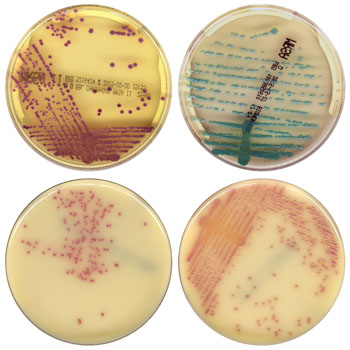Automated Image Analysis Software Reliably Identifies Positive MRSA
By LabMedica International staff writers
Posted on 24 Feb 2016
In a unique-in-its-class digital microbiology study of almost 60,000 samples, new WASPLab software developed for automated colony-scoring of chromegenic media plates provided superior detection of methicillin-resistant Staphylococcus aureus (MRSA).Posted on 24 Feb 2016
The groundbreaking results came from an international multicenter study, testing 57,690 samples, where the WASPLab platform software “Chromogenic Detection Module” (CDM) from COPAN Diagnostics, Inc. (Murrieta, CA, USA) detected and segregated positive from negative MRSA samples using chromogenic agar with a sensitivity of 100% and a specificity of 90%–96% (varying by location). The software detected an additional 153 positive MRSA patients that were missed by manual reading.

Image: Automated colony-scoring of chromogenic media agar plates for the detection of MRSA using the WASPLab image analysis software (Photo courtesy of COPAN Group/PRNewsFoto).
The study's sample size and level of sensitivity of 100% “makes this study unmatched in the industry," said Norman Sharples, CEO, Copan Diagnostics.
CDM utilizes an algorithm to identify presence of colonies on a plate and distinguish between different colors to group into negative and positive cultures. The study focused on identifying MRSA using chromogenic agar from 3 different manufacturers (BD Diagnostics, bioMeriéux, Bio-Rad Laboratories) that produce growth with different pigmentation colors. The cultures were read automatically by WASPLab CDM and manually by a laboratory professional. The laboratory professionals were blinded to the software's results.
CDM's reading threshold is intentionally set with a high level of prudency designed so it does not miss a positive MRSA culture. In fact, in this large study, CDM never reported any manual positive plates as negative, demonstrating 100% sensitivity. The 90%–96% specificity score varies by location due to the conservative threshold of the CDM settings, which set the limitations low in order to avoid any "false negative" interpretation. Most importantly, the data from this study suggests that the CDM software is somewhat more sensitive than manual reading of plate cultures.
The software’s “capability reduces the hands-on time considerably,” said Dr. Sharples, “CDM is not meant to be used without the technologist, but to provide the technologist with valuable tools that rapidly pre-screen cultures, detect the presence of specific organisms of interest or known pathogens, then segregate cultures into positive and negative groups that enable faster turnaround times and actionable results within the therapeutic window."
The results of the data show that the WASPLab CDM can be used to accurately sort regardless of the chromogenic substrate. Its application for MRSA is only the first step in a series of algorithms developed by COPAN and available to WASPLab users to further the relevance and speed of laboratory results.
"Clinical microbiology relies heavily on the reading and interpretational skills of the technologist and microbiologist. In a time of diminishing resources and increasing work volumes the advancement in these imaging algorithms supports the value of digital microbiology and full laboratory automation for the continued output of quality results and improved patient care," concluded Dr. Sharples.
The study, by Faron ML et al., was published online ahead of print December 30, 2015, in the Journal of Clinical Microbiology.
Related Links:
COPAN Group









 assay.jpg)



